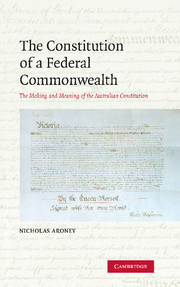Book contents
- Frontmatter
- Contents
- Preface
- Table of statutes and executive instruments
- Table of cases
- Introduction: Australia as a federal commonwealth
- PART I Federalism
- PART II Federating Australia
- PART III Australian federation
- 7 Principles of representation
- 8 Representative institutions
- 9 The states and the Commonwealth
- 10 Configurations of power
- 11 Amendment procedures
- PART IV Conclusions
- Select provisions
- Bibliography
- Index
8 - Representative institutions
Published online by Cambridge University Press: 05 August 2012
- Frontmatter
- Contents
- Preface
- Table of statutes and executive instruments
- Table of cases
- Introduction: Australia as a federal commonwealth
- PART I Federalism
- PART II Federating Australia
- PART III Australian federation
- 7 Principles of representation
- 8 Representative institutions
- 9 The states and the Commonwealth
- 10 Configurations of power
- 11 Amendment procedures
- PART IV Conclusions
- Select provisions
- Bibliography
- Index
Summary
There is no constitution which I know of in existence in Australia, or in any other British community, which provides within its four corners, with the definiteness which is proposed by this resolution, that there shall be responsible government – that there shall be an executive, whose existence must depend on the goodwill and support of the popular house. It appears to me that there is no such constitution in existence; and as has been pointed out by the hon. member, Sir Samuel Griffith, in the absence of such a provision responsible government in its ordinary sense can hardly be deemed an essential of any Australian constitution.
Charles Kingston (1891)A majority of the framers accepted that the autonomy and equality of the colonies was an unavoidable presupposition of Australian federation. Some, like Alfred Deakin and John Quick, saw it as a necessary concession, others as a normative principle, but they agreed that it meant that the states must be equally represented in one house of the Federal Parliament. It was only a minority of rigorous nationalists, such as H. B. Higgins, who started from the premise that the federation must be founded upon the ‘sovereign people’ of the entire nation and concluded that representation in both houses should be in proportion to population.
These basic perspectives led to diverging conclusions when it came to defining the structure of the federal government in more precise terms. As has been seen, if nationalists could not compromise the principle of equal representation in the Senate, they sought to qualify its powers – as a dictate of both national democracy and responsible government.
- Type
- Chapter
- Information
- The Constitution of a Federal CommonwealthThe Making and Meaning of the Australian Constitution, pp. 215 - 246Publisher: Cambridge University PressPrint publication year: 2009



